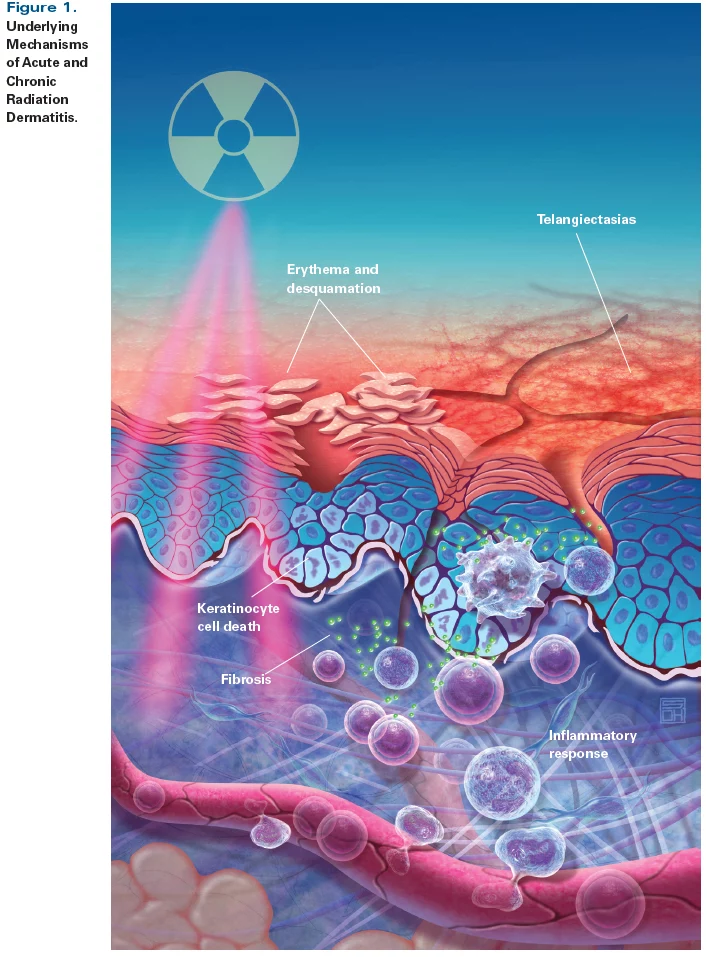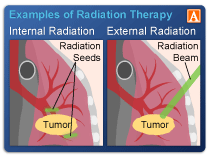
Diagnosed with Cancer? Your two greatest challenges are understanding cancer and understanding possible side effects from chemo and radiation. Knowledge is Power!
Learn about conventional, complementary, and integrative therapies.
Dealing with treatment side effects? Learn about evidence-based therapies to alleviate your symptoms.
Click the orange button to the right to learn more.
- You are here:
- Home »
- Blog »
- side effects ID and prevention »
- Radiation Dermatitis- Cream, Dressing, Film
Radiation Dermatitis- Cream, Dressing, Film

“A common side effect is a skin condition called radiation dermatitis, also known as X-ray dermatitis or radiation burns. Concentrated exposure to radiation causes painful marks on the skin”
Radiation Dermatitis, the damage done to your skin that is a result of radiation, probably won’t kill you. It is one of those side effects that 85% of those cancer patients who are treated with radiation (66% of the 1.6 million newly diagnosed cancer patients in the U.S. annually) suffer from.
Keep in mind however, that chronic radiation dermatitis can be a serious late stage side effect.
Radiation burns are what I am referring to when I lament, “I wish I knew then what I know now.” If you are about to undergo local radiation to treat your cancer, you can take several steps to help you reduce or even eliminate radiation dermatitis aka radiation burns.
I had three courses of local radiation during my conventional cancer treatments in ’95-’97. One series to my neck and two separate series of radiation therapy to my lower back.
I suffered from typical radiation burns that scarred my skin and caused pain (maybe a 5 on a pain scale from 1-10) for about 10 years. The skin on my lower back still hurts on occasion but I’ve gotten used to it.
It is important to stress that the same local radiation therapy caused the common side effects
- dysphagia
- mucositis and
- radiation-induced limbo-sacral plexopathy
Because these long-term side effects are much more debilitating, I have spent much more time researching and writing about these health problems.
- Radiation for DCIS?
- Healing Radiation-induced Dysphagia- Difficulty Swallowing
- Healing Radiation-Fibrosis- Xerostomia aka Dry Mouth
- Chemo Radiation- induced muscle atrophy
- Small Cell Lung Cancer Therapy- Whole Brain Radiation
Like all conventional therapies, radiation is a double-edged sword. Please don’t expect your oncologist to educate you about possible short, long-term and late stage side effects.
Scroll down the page, post a question or a comment and I will reply to you ASAP.
Hang in there,
David Emerson
- Cancer Survivor
- Cancer Coach
- Director PeopleBeatingCancer
Radiation Dermatitis
“A common side effect is a skin condition called radiation dermatitis, also known as X-ray dermatitis or radiation burns. Concentrated exposure to radiation causes painful marks on the skin…
Nearly two-thirds of people with cancer are treated with radiation therapy. Of those people, roughly 85 percentTrusted Source experience moderate-to-severe skin reactions.
These typically occur within the first two weeks of treatment and can last for several years after therapy is completed.
During radiation treatment, concentrated X-ray beams pass through the skin and produce irradiated free radicals. This causes:
- tissue damage
- DNA damage
- inflamed skin (affects both the epidermis and dermis, or outer and inner layers of skin)
With the right approach, this side effect can be reduced or eliminated. The best method is to combine topical and oral treatment options.
1. Corticosteroid cream-
2. Antibiotics-
3. Silver leaf nylon dressing
Burns on the skin are typically treated with gauze. When it comes to radiation burns, though,studies showTrusted Source silver leaf nylon dressing is one of the best options available.
This skin dressing is effective because of its antimicrobial and anti-infective properties. The silver ions used in the nylon dressing release into the skin and work quickly to relieve discomfort and improve recovery.
It is also helpful for relieving symptoms of:
4. Zinc
5. Amifostine
According to clinical trials, chemotherapy patients using amifostine had a 77 percent reduced risk of radiation dermatitis compared to those who didn’t use the drug.
The U.S. Food and Drug Administration (FDA) has approved the injectable form of amifostine. It’s only available via prescription, so you have to speak with your doctor about using this treatment option…”
Chronic radiation-induced dermatitis: challenges and solutions
“Chronic radiation dermatitis is a late side effect of skin irradiation, which may deteriorate patients’ quality of life. There is a lack of precise data about its incidence; however, several risk factors may predispose to the development of this condition. It includes:
- radiotherapy dose,
- fractionation,
- technique,
- concurrent systemic therapy,
- comorbidities, and
- personal and genetic factors.
Clinical manifestation includes:
- changes in skin appearance,
- wounds,
- ulcerations,
- necrosis,
- fibrosis, and
- secondary cancers.
The most severe complication of irradiation is extensive radiation-induced fibrosis (RIF). RIF can manifest in many ways, such as skin induration and retraction, lymphedema or restriction of joint motion.
Diagnosis of chronic radiation dermatitis is usually made by clinical examination. In case of unclear clinical manifestation, a biopsy and histopathological examination are recommended to exclude secondary malignancy.
The most effective prophylaxis of chronic radiation dermatitis is the use of proper radiation therapy techniques to avoid unnecessary irradiation of healthy skin.
Treatment of chronic radiation dermatitis is demanding. The majority of the interventions are based only on clinical practice.
- Telangiectasia may be treated with pulse dye laser therapy.
- Chronic postirradiation wounds need special dressings.
- In case of necrosis or severe ulceration, surgical intervention may be considered.
Management of RIF should be complex. Available methods are
- rehabilitative care,
- pharmacotherapy,
- hyperbaric oxygen therapy, and
- laser therapy.
Future challenges include the assessment of late skin toxicity in modern irradiation techniques. Special attention should be paid on genomics and radiomics that allow scientists and clinicians to select patients who are at risk of the development of chronic radiation dermatitis. Novel treatment methods and clinical trials are strongly needed to provide more efficacious therapies.
Mepitel Film for the Prevention of Acute Radiation Dermatitis in Breast Cancer:
“Radiation dermatitis (RD) is common in patients undergoing breast radiotherapy. Mepitel film (MF) can reduce RD…
RESULTS-Between January 2020 and May 2022, 376 patients were included in the modified intention-to-treat analysis. The incidence of G2 or 3 RD was significantly lower in MF patients compared with standard care (n = 39/251, 15.5%; 95% CI, 11.3 to 20.6% v n = 57/125, 45.6%; 95% CI, 36.7 to 54.8% respectively…
Benefits of MF remained significant in patients who developed G 3 RD and moist desquamation…When evaluating the combined patient and health care provider score using Radiation-Induced Skin Reaction Assessment Scale, the MF arm had significantly lower scores…
Individual items on the Radiation-Induced Skin Reaction Assessment Scale also favored the MF for both patient- and clinician-reported outcomes. Blistering/peeling, erythema, pigmentation, and edema were significantly reduced in the MF arm. Three patients removed the film prematurely because of rash (n = 2) and excessive pruritus (n = 1).


